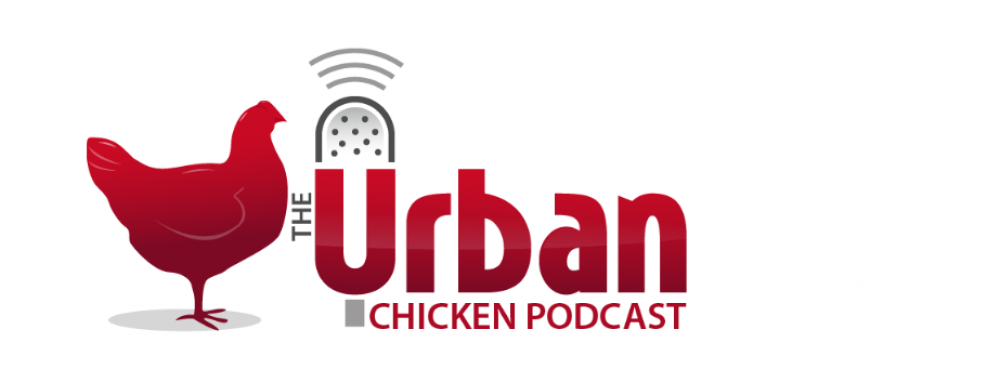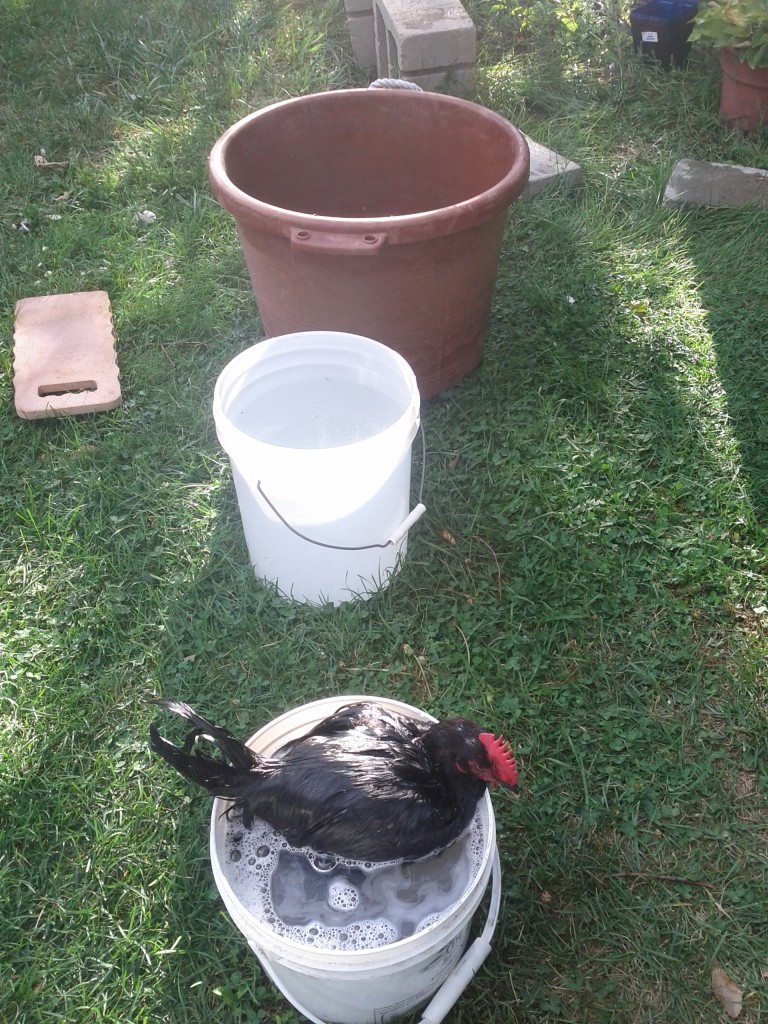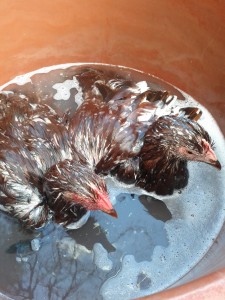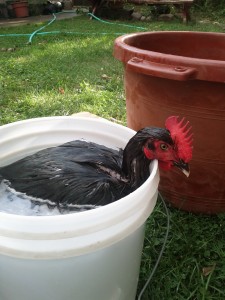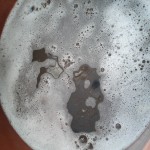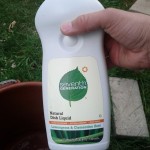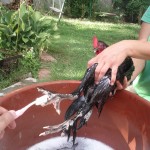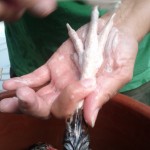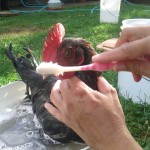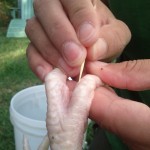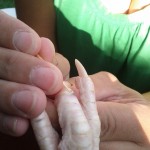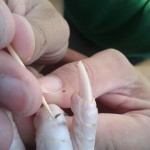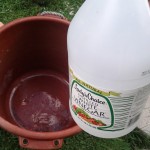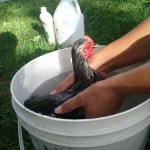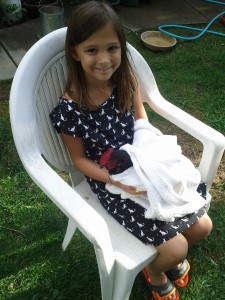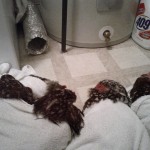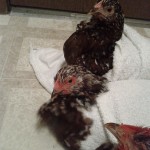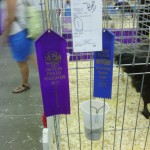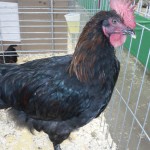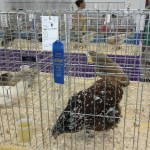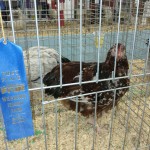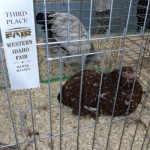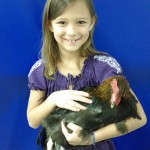Earlier this month, my sister and I dipped our toes into the pool of competitive chicken shows by entering several birds at our local county fair. When I first started down the backyard chicken trail, I would have never considered getting into showing chickens. So what changed?
New birds.
In fact, I have lots and lots of new chickens in my life which I have been remiss in telling you (the Urban Chicken Podcast family) all about. Late this past spring, I was generously gifted about 2 dozen rare and fancy breed day old chicks. I have been sharing those birds with my sister and niece (a few living at my house and the bulk of birds at hers). Consequently we have decided to try our hands at chicken breeding and hatching with some of the recent additions to our flock.
We are now at a point where between our established flocks and all of the newbie birds, we have more chickens than we know what to do with – and they keep growing and eating more and more. The hard truth is that we need to figure out which of our birds are of breeding quality and which are just pretty duds.
The timing of the local American Poultry Association (A.P.A.) sanctioned poultry show at our county fair was perfect! We could take a bunch of the birds that we really needed some professional feedback on and enter them into the chicken show. The birds would be inspected and judged by an A.P.A. certified poultry expert, and he would be able to give us the insight that we needed to move forward.
Now entering chickens into a show involves more than just scooping your birds out of the backyard and dropping them off at the fairgrounds. There is an important primping process involved in getting your chickens ready to strut their stuff for the judges. Today on the Urban Chicken Podcast, I walk you through how to get your birds ready to show – a process that I just experienced firsthand for the first time recently.
Like any beauty contest there are some tricks of the trade on getting gussied up for the judging.
Bathing Your Birds
The most critical part of preparing you birds for show is giving them a good and proper bath. Some sources will tell you to bathe the birds 5-7 days before show. I don’t necessarily agree with that suggestion. My sister and I washed our birds just two days before the show. The thought behind the 2 days window was that there would be enough time for the birds to fully dry and preen but not so much time that they could get dirty again before being judged.
I’m not going to lie to you, chickens are super not particularly keen on bathing. You will likely end up fairly wet and smelling of wet bird by the end of the bird bathing process. Don’t let a little chicken bath water deter you though – it’s a very doable process and not horrible. Though most chickens don’t like having a bath, if you have the water perfectly warm some chickens (once they accept that they’re all wet and stuck in a bath) seem to relax and
enjoy the warmth of the water. A couple of our birds acted like they were nodding off in the bath. One word of caution, be sure that your water is not too hot, you don’t want to scald your chicken’s feathers or skin.
For our bathing process, my sister and I used the three bucket method out in her backyard. Some chicken sources on-line suggest that you wash your birds in your kitchen sink. I can understand the argument for using one’s kitchen sink, certainly it is easier control the water temperature and rinse the bird than with the bucket system. I however, do not personally subscribe to the kitchen sink method simply because the idea of washing dirty chickens where I prepare my food grosses me out. Your chickens may look relatively clean, but I assure you that once you
get them in a bath, you will be surprised by how filthy they actually are. If I were inclined to wash my chickens inside my house, the bath tub would seem a more tolerable location to do so.
Regardless of whether you choose the three bucket method in the yard or use a sink inside the house, the process of properly washing your birds is the same. Under the three bucket method, each bucket represents a different step in the bathing process. If you are using your sink or tub you replicate each of the bucket bath stages.
The first bucket is soap bath step. In this bucket you add a mild dish soap to the warm water. This stage of the bathing process is where you will actually remove all of dirt poop and other gunk from your bird’s feathers, feet, comb and wattles. Gently work the soapy water into the bird’s feathers. Be gentle and only work the soap and soapy water stroking in the direction of the feathers – or you will break feathers otherwise. During the soapy bath, use an old toothbrush (now dedicated strictly to bathing birds) to scrub dirty legs and feet, beaks combs and wattles. I should note that we did not scrub any of our birds’ earlobes. I have read that wet ears can make birds much more susceptible to catching a chill and getting ill. Is that true? I really do not know, but decided to error on the side of caution.
- Mild Soap for Bathing
- Marans Feet Scrubbing
- Jubilee Feet Scrubbing
- Washing Comb
It is also during the soapy bath stage that you scrub your bird’s legs. We entered several Jubilee Orpingtons, a variety of chickens with white legs, into the fair for judging. It is worth noting that it required considerably more soaking and multiple scrubs with the toothbrush to get their white legs clean. On a couple of the Jubilees there was dirt up under the scales of their legs which no amount of scrubbing was going to remove. We were able to clean that dirt up by carefully using a toothpick to scrape under the dirty leg scales. It is sort of like cleaning dirt out from under one’s fingernails. We only attempted using the toothpick in this fashion, after the bird’s legs had been soaking for a while and were softer.
After the soap bath, the second bucket is the vinegar water bath. I added about 1/2 – 1 cup of white vinegar (though apple cider vinegar would also work quite well) to a large bucket of warm water (3-5 gallons). The vinegar bath step is beneficial to your birds for several reasons. First, vinegar is non-toxic to birds and will help remove any soap residue from the bird’s feathers. Second, vinegar brings out the shiny quality of a bird’s plumage. And third, a good soak in vinegar water can kill mites and other creepy-crawlies. While each of our chickens was in this bath, we
worked the vinegar water through their feathers all over their bodies.
The final tub in the three bucket method is simply a bath of plain warm water. This final bath is the final rinse to remove any remaining dirt, soap or vinegar from the bird’s body. Some competitors like to add a few drops of glycerin to this final rinse bath to help improve the sheen of the bird’s feathers. My sister and I did not use glycerin on our birds and so I do not have any experiential insight on the use of glycerin.
WHITE BIRDS EXTRA BATHING STEP
If you have all white birds that you are preparing for show, there is an additional bathing step required. In between the soapy bath and the vinegar rinse bath you need to add a bluing bath. Bluing is a substance that has been used for centuries with laundry, to make whites appear more brilliant and crisp. Today, there is now animal bluing products that are non-toxic and which can be used on your white pets (Like this one: ShearPrecision Nature’s Choice Aloe Bluing Pet Shampoo).
Here is the concept behind bluing – whites sometimes become dingy in color turning grey or yellow. This can commonly happen when white feathered birds are either in the direct sun too much or fed corn, which discolors white feathers. Blue and yellow are complementary colors. When bluing is added to a yellowed objected, it affects the color wavelengths produced by the object and actually changes the human eye’s perception of the color. In a nutshell, adding blue to your dingy whites will make your whites appear whiter. The effect is not permanent though and the bluing does eventually wear off. If you use animal bluing on your white birds you have to be very careful. If you overdo it on the amount of bluing used or allow the bird to soak in bluing for too long you will end up with a blue bird, not a whiter one.
Drying Your Wet Birds
The next step in preparing your chickens for show, is to dry them. It is noteworthy that birds are not able to regulate their body temperatures when their feathers are soaking wet. Consequently, even though it may be comfortably warm in your yard, when you bathe your birds they may become chilled afterwards. Remember: a chilled bird very easily can become a sick bird.
To avoid your bathed chickens from getting chilled, I strongly suggest that you dry your birds. First, wrap the freshly washed bird in a clean towel to soak up much of the water. Next, you should blow dry the wet bird gently on a warm-setting. Don’t use the hot-setting on your blow dryer as you can easily scorch your bird’s feathers this way.
My sister and I dried our bathed birds in an unusual, but highly effective manner. Since we were washing several birds in a row, we did not have time to individually blow dry each bird. Instead, we wrapped each bird tightly in a towel (this discourages escape and running around). We them detached my sister’s clothing dryers vent from the wall and set it on the floor of her laundry room. We then laid out each of the towel-wrapped chickens in front of the blowing laundry dryer vent on the floor. My sister was able to get double value during the drying stage as she was drying her clean laundry and drying our wet birds at the same time.
- Detached Dryer Vent
- Dried All the Birds Simply
Using the laundry dryer vent hose in this fashion worked great! We saved a lot of time, effort and energy being able to dry the birds together as a group. Additionally, under this dryer-vent method there was no risk of scorching feathers. Most of our birds seemed to enjoy the drying process – closing their eyes and dozing off during this blow dry. This is an easy and effective alternate to using a hairdryer on your birds.
Trimming Up Beaks and Nails
After each of the chickens is washed, rinsed and dried, they then need to have their nails and beaks clipped and filed.
Clip your bird’s beak if the top beak creates an overbite to the bottom beak. To accomplish a proper beak trimming you can use a simple pair of animal nail clipper (see for example: Kaytee Small Animal Pro-Nail Trimmer) to take small nips off of the beak. Follow up clipping the beak with a good filing with the use a new emery board. Sand away any points or rough edges off where you clipped and shape the affected area to follow the natural curve of the beak.
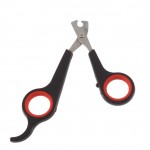 Next, clip and shape your bird’s nails. Just like a cat’s or dog’s nail, chicken nails have a quick. If you are unfamiliar with what a nail quick is, it simply is a portion of an animal’s nail that has blood capillaries and some nerve endings. If you cut an animal’s nail too short, thereby cutting the quick, the nail will profusely bleed and be painful to the animal. Moreover, a nail trimmed to shortly into the quick may open the creature up to infections through that cut. Be sure to have some stop bleeding agent, such as Kwik Stop (Kwik Stop – 1/2 oz) or corn starch on hand, just in case you do clip too short.
Next, clip and shape your bird’s nails. Just like a cat’s or dog’s nail, chicken nails have a quick. If you are unfamiliar with what a nail quick is, it simply is a portion of an animal’s nail that has blood capillaries and some nerve endings. If you cut an animal’s nail too short, thereby cutting the quick, the nail will profusely bleed and be painful to the animal. Moreover, a nail trimmed to shortly into the quick may open the creature up to infections through that cut. Be sure to have some stop bleeding agent, such as Kwik Stop (Kwik Stop – 1/2 oz) or corn starch on hand, just in case you do clip too short.
After you have clipped the bird’s nails, use the emery board to sand the tip of the nail back to a rounded shape. The cut nail should never be filed flat, as this is not a natural shape for a chicken’s nail.
Final Touches
There are a couple final touches you should do before your birds are judged. On the day of judging we took each of our birds from their cages and did these final three steps.
First, we checked each bird’s feet and bum to make sure there was not any unpleasant poo hanging about that we could clean off before the judge handled them. though the judges may be used to chicken poop, no one likes to get it on them.
Second, we took a very small amount of Vaseline in our finger tips and rubbed that into the combs, wattles and legs of our birds for a healthier, shinier, more beautiful appearance. Other on-line chicken resources suggest using mineral oil or VetRx cream (Vetrx Poultry Remedy – Vet-Py-2Z-X – Bci,2 fl.oz) for this same purpose. Regardless of which product that you decide to use to shine up your bird, be careful at this step. It is very easy to use too much of product and get a greasy look in the bird’s head feathers.
Lastly, we used a 100% silk scarf, purchased for $2 at a thrift store, to rub over the bird’s feathers right before the judging. Stroking a bird’s feathers several times with a pure silk scarf helps fix ruffled feathers as well as add a shiny look to their plumage. The effect by using a silk scarf on your birds is distinctly noticeable.
- Best of Breed Winner
- Best of Breed Marans
- 1st Place Jubilee Orpington
- 1st Place Jubilee
- 3rd Place Jubilee
- Lydia & Marans Winner
The efforts we took to primp our chickens for showing at the fair seemed to have worked. Every one of our birds won a ribbon (a couple taking first place) and one of our Black Copper Marans cockerels won “Best of Breed.” We must have done something right.
We also got the opportunity to speak to the judge My sister got to speak afterwards at length about our chickens and get some very useful tips on how to breed our stock for better results next year. Overall, it was a total hoot having chickens entered into competition and we plan on going back again next year armed with a little experience and a lot more information.
A Parting Question to Consider
One last thought, I have a question I’d like to pose to you.
One of our Jubilee Orpington pullets has a few stub feathers growing on her legs and toes. Jubilees are not supposed to have leg or feet feathers – it is a genetic defect in the breeding. For our first show, we left these stub feathers on our pullet in the spirit of fairness. However, a judge told us that it is fine to soak a bird’s legs prior to show and pluck these feathers. When we asked whether that was not cheating, we were told that it was not. Rather, plucking stub feathers is just another step in cleaning up the bird for show.
It was explained to us that plucking stub feathers was legal because your are removing an unwanted item from the bird, but adding to the bird would be cheating. So for example, if you had an all-black bird with a few freaky white feathers, dying the white feathers black to match would be cheating. As an aside, I have actually heard of this being done in competition using a Sharpie marker. The exhibitor was caught when sharpie black ink came off of the bird and onto the judge’s hands.
What do you think? Do you agree that plucking stub feathers off a clean-legged breed for show is fair? Or do you think it is cheating on par with Sharpie coloring your birds’ feathers? You can share your opinion in the comments section for this episode on the Urban Chicken Podcast’s Facebook page (click here).
CHICKEN NEWS:
- NBC News – West VA Crash Spills Chickens, AK-47, Pot and Fireworks ARTICLE
- WOWKTV – I-79 Back Open: Chickens & Ammo to Blame for Shutdown VIDEO
- WVGazette – Police: SUV that crashed had IEDs, guns, pot, chickens ARTICLE
- Lowering the Bar – Sovereign Citizen’s SUV Loaded w/ Chickens & Ammo ARTICLE
MAIN SEGMENT:
- Pet Bluing Shampoo – Nature’s Specialties Bluing Pet Shampoo with Optical Brighteners, 32-Ounce
- Backyard Poultry Magazine – Bathe Chickens ARTICLE
- Angie Griffin (Australian?) did 4-part video of washing chickens (info is good but wish she would’ve righted the videos) VIDEO 1, VIDEO 2, VIDEO 3, and VIDEO 4
- Natural Chicken Keeping – Preparing Your Chicken for Poultry Show ARTICLE
- BYC Forum – Tricks and Tips for Making Bird Look Its Best for Show THREAD
- Pathfinders Farm – Conditioning and Prepping for Shows ARTICLE
- Poultrykeeper – Tips & Tricks for Exhibiting Show Chickens 26 TIPS LIST
- Harvest Breeze Farm – Preparing for Show PHOTO BLOG
- PoultryShowCentral – CHicken Show Prep ARTICLE
- BrownEggBlueEgg – Washing Eggs ARTICLE
SALLY’S SIDENOTES:
- Support the Urban Chicken Podcast by shopping Amazon starting here: Amazon
- If Amazon is not your thing – you could also support the show HERE
Podcast: Play in new window | Download | Embed
Subscribe: Apple Podcasts | RSS
